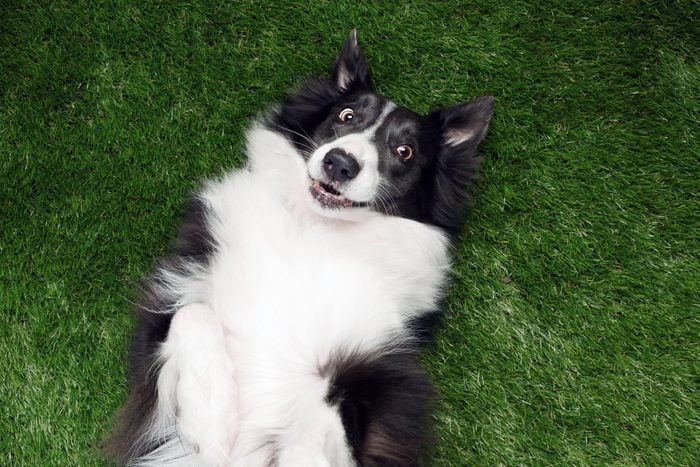How to Teach a Dog to Roll Over—and Build on Your Bond in a Fun Way
Updated: Jul. 18, 2023

Dog tricks aren't just for impressing guests. Teaching your dog how to roll over can boost their confidence, keep them mentally stimulated and strengthen your bond.
Learning to roll over—just like learning to fetch—might not be an indispensable life skill for the average pup. Certainly not the way “sit,” “come” or other practical dog commands can be. However, professional dog trainer Blythe Neer says that learning how to teach your dog to roll over is not only fun, it’s an important bonding activity. “It promotes feelings of trust and safety when trained at the dog’s pace with lots of rewards,” Neer says.
Plus, training a dog to do these types of dog tricks is a great way to provide much-need mental stimulation, says Erin Askeland, a professional dog trainer. It keeps your dog’s brain active, builds problem-solving skills and “can help a dog learn more body control and awareness,” Askeland says.
Want to impress your guests with this classically cute trick? With the help of the experts, we’ve created step-by-step instructions so you can train your puppy, adult dog or senior pooch to make rolling over rewarding for both of you.
Get Reader’s Digest’s Read Up newsletter for more pet tips, humor, cleaning, travel, tech and fun facts all week long.
What is the best age to teach a dog to roll over?
While a dog is never too old to learn, Askeland does point out that rolling over can be hard on their bodies. Age, mobility levels and health all influence how safe the trick is for a dog to tackle. Askeland says that dogs with long bony spines, large chests or arthritis can find this trick particularly challenging. “If a dog has known health issues or is not willing to roll over, it may be best to try a different trick,” she recommends.
If in doubt, consult with your veterinarian or a certified canine rehabilitation therapist before adding roll over to your dog’s repertoire.
What you’ll need to teach a dog to roll over
Fortunately, you don’t need a ton of dog-training items when learning how to teach a dog to roll over, just a few puppy essentials. The list below is all you’ll need to get started.
- A quiet, familiar and enclosed space
- High-value dog training treats
- A ball or other motivating dog toy (if your dog isn’t food motivated)
- Patience, enthusiasm and time
How to teach a dog to roll over
While the exact process will vary depending on your dog and how quickly it offers certain dog behaviors, following these simple steps can set you both up for success.
Step 1: Select a suitable space
The goal is to limit distractions. While your dog may love getting exercise at a dog park, teaching a dog to roll over in front of other pups or in a room full of kids isn’t a sensible strategy. Make sure to choose a quiet room or peaceful fenced-in yard that’s familiar to them.
Pro tip: Consider the flooring. “Choose a soft floor—grass, carpet, rug, yoga mat—to teach roll over, so that your dog is comfortable and not slipping,” Askeland says.
Step 2: Teach a reliable “down”
If your dog doesn’t already lie down on command, you’ll need to master that first. Once your dog is sitting, hold a treat to their nose, moving it slowly down to their chest. As your dog follows the treat with their nose, bring it down to the ground, away from their paws and toward you. The idea is to lure them into a down position.
As soon as they are lying down, reward them with a treat. Repeat the process until your dog reliably offers the desired position. Then, introduce the “down” verbal cue, and gradually phase out the hand signals and treats.
Pro tip: Reward heavily. Neer emphasizes the importance of rewards during all stages of teaching. Both treats and verbal praise keep dogs motivated and help them understand when they are offering a behavior you are looking for.
Step 3: Lure your dog onto their side
From the down position, work on luring your dog onto their side. Once again, hold a tasty treat right in front of their nose. Encourage them to follow the treat by slowly moving it toward their shoulder. If your dog isn’t moving onto their side, break things down further by repeatedly rewarding their head turn first.
If your dog favors resting on one hip in the down position, lure them in that direction as they will more naturally fall onto their side from this position. Repeat the process multiple times, rewarding immediately every time your dog rolls onto their side. And remember: Always hold the treat close to their nose and take things slowly.
Pro tip: Take it one step at a time. Askeland says that breaking down this complex trick into baby steps helps you move at the dog’s learning pace. You’re more likely to confuse your dog by asking for too much at once.
Step 4: Work toward a full roll over
Now that your dog is reliably rolling onto its side, progress to luring them over further onto their back and over to the other side. Do this by slowly moving the treat from their shoulder toward their backbone, and then the floor.
Repeat the process with lots of praise, enthusiasm and well-timed, tasty treats until your dog is reliably rolling right over.
Pro tip: Pay attention to your dog’s facial expressions and behavior and look for any signs of discomfort. Askeland points out that rolling onto the back can be a vulnerable position for dogs. Always ensure they are comfortable and stop the session immediately if they show any signs of anxiety or discomfort.
Step 5: Introduce the “roll over” cue
Once your dog reliably offers a full body roll, it’s time to introduce a verbal cue. When you start the luring action, pair it with an enthusiastic and clear “roll over.” Combine this cue with the lures and rewards for a few more sessions.
Pro tip: Askeland says that you should be able to fade out the luring hand signals and rely on the verbal cue after a few sessions. But don’t make a common dog training mistake by forgetting to praise and reward them for their efforts.
Step 6: Practice the trick in new places
Once your dog has mastered the trick in a quiet and familiar space, it’s time to up the ante to generalize the behavior. Maybe ask them to roll over in the backyard for the next few sessions before moving to a familiar dog park.
Pro tip: Want to really test their new skill? Have a friend ask your dog to roll over and put their new trick to the test.
What to do if your dog isn’t rolling over
Some dogs are easy to train and pick up rolling effortlessly. For others, it might not come so naturally—even if they are some of the smartest dogs. If you’re struggling to get your dog to go from lying on their side to rolling over (or if they don’t seem to understand what you’re asking for), don’t panic. Stop for the day and use these tips to strategize your next session.
- Be patient. “Regardless of the way you teach it, you need to be sure to go at your dog’s pace and not expect too much too soon,” Askeland says.
- Get it right with rewards. Pick treats or toys your dog can’t resist. This helps keep them motivated and happy to train. Pieces of dry kibble likely aren’t going to cut it.
- End on a high note. Keep sessions short, enthusiastic and fun, always aiming to end with a win. Training a bored, frustrated or tired dog isn’t a recipe for success.
What not to do when teaching your dog to roll over
- Don’t force a position. “Never force the dog to roll over by grabbing their legs or flipping them over,” Askeland says. “This can be scary and even hurt a dog.” Neer advises against any modeling, a technique in which the trainer physically positions the dog to do what is desired. She also advises against corrections of any kind, including slip leads, prong collars or e-collars.
- Don’t train when tetchy. Learning how to teach a dog to roll over should be fun for you both. “Make sure you’re training when you are feeling calm and patient,” she says. “Otherwise, walk away and try again later.”
- Don’t continue if your dog isn’t comfortable. This isn’t an essential skill. If your dog shows signs of pain or isn’t enjoying the sessions, stop and try something else instead.
About the experts
- Erin Askeland is an animal health and behavior expert and certified professional dog trainer at Camp Bow Wow. She is an animal welfare professional with an MSc in Clinical Animal Behavior and is also a Certified Behavior Consultant Canine and Fear Free Certified Professional.
- Blythe Neer, CPDT-KA, ADT, CCUI, is the founder and head trainer at Delta Tails. She is multi-certified, with credentials from the International Association of Animal Behavior Consultants, Fear Free Pets, Association of Professional Dog Trainers and Leslie McDevitt.



